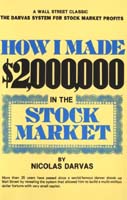curiouscat.com > Books > Investment > Investors > Nicolas Darvas
More investors: Buffett, Livermore, O'Neil, Soros
Nicolas Darvas wrote a classic investment book - How I Made $2,000,000 in the Stock Market. In it he provides an honest and open look at his experience from his naive start to his eventual success. He lays out, in great detail, exactly what he did and how foolish some of his actions were. Then he explains how he came to find success by focusing on the price and volume action of stocks. While honing his investment strategy, in the 1950's, he traveled the world working as a world class ballroom dancer and placed order via cable.
As with other classic investing books age does not detract from this books value. The book is very similar in form to another classic: Reminiscences of a Stock Operator by Edwin Lefevre (about his experience in the early 1900s).
Darvas' method was a forerunner of the many technical analysis schemes used today. He is extensively referenced by William O'Neil (of Investor's Business Daily fame) and other leading technicians. An extremely simplified overview of Darvas' method: determine "boxes" (trading ranges) for a stock and buy on the breakout, to the upside, of the box. He used very close trailing stop loss orders to minimize losses. He sought to make large gains (let his winners run) and take losses quickly.
He explained his attempt to find attractive investments this way (on page 49 How I Made $2,000,000 in the Stock Market):
If a tempestuous beauty were to jump on a table and do a wild dance, no one would be particularly astonished. That is the sort of characteristic behavior people have come to expect from her. But if a dignified matron were to suddenly do the same, this would be unusual and people would immediately say, "There is something strange here - something has happened."
He sought out stocks that were behaving strangely and then determined if the would make good investments. Not feeling obligated to promoting the value of technical analysis, he stated on page 67 of How I Made $2,000,000 in the Stock Market.
Gradually, I began to understand I could not apply mechanical standards to the relationship between the [Dow Jones] Average and individual stocks. Judging this relationship was much more like an art... From then on, I made up my mind to keep watching the Dow-Jones Industrial Average, but only in order to determine wether I was in a strong or weak market. This I did because I realized that a general market cycle influences almost every stock.
The 1980 reissue of How I Made $2,000,000 in the Stock Market includes an fascinating 20 page question and answer section detailing his methods.
In 1964, Darvas wrote Wall Street: The Other Las Vegas (republished in 1986) another interesting boook. The first three quarters of the book is disappointing. And even though many of the trades eviler in the book are the same ones explored in his previous book, the gems buried in this book make it a worthwhile read. From page 131 (emphasis in the form of capitalization directly from the book):
MY ONLY SOUND REASON FOR BUYING A STOCK IS THAT IT IS RISING IN PRICE. IF THAT IS HAPPENING, NO OTHER REASON IS REQUIRED. IF THAT IS NOT HAPPENING, NO OTHER REASON IS WORTH CONSIDERING.
He further refines this idea on page 144 stating "that the only stocks which would be of any interest to me would be those that were breaking all previous records: stocks not merely rising in price, but actually in their highest boxes ever. On page 149 he mentions how he searched for potential stocks: he scanned for those stocks with a high that at least doubled the low for the year. He then started looked at those that were within a few points of the high. Later on that page he notes "I then subjected them to further tests, but these were largely dependant on judgement and no absolute rules could be laid down for them." These boiled down to what he called his Techno-Fundamentalist method relying on volume, breakouts, "story" and expected earning.
His, You Can Still Make It in the Market, has been republished after a long absense from the market. Some think it is not as worthwhile as his more famous book but it has some great details on his box system (named DAR*CARD in the book) that will be useful to anyone serious about attempting to trade in a Darvas style.

